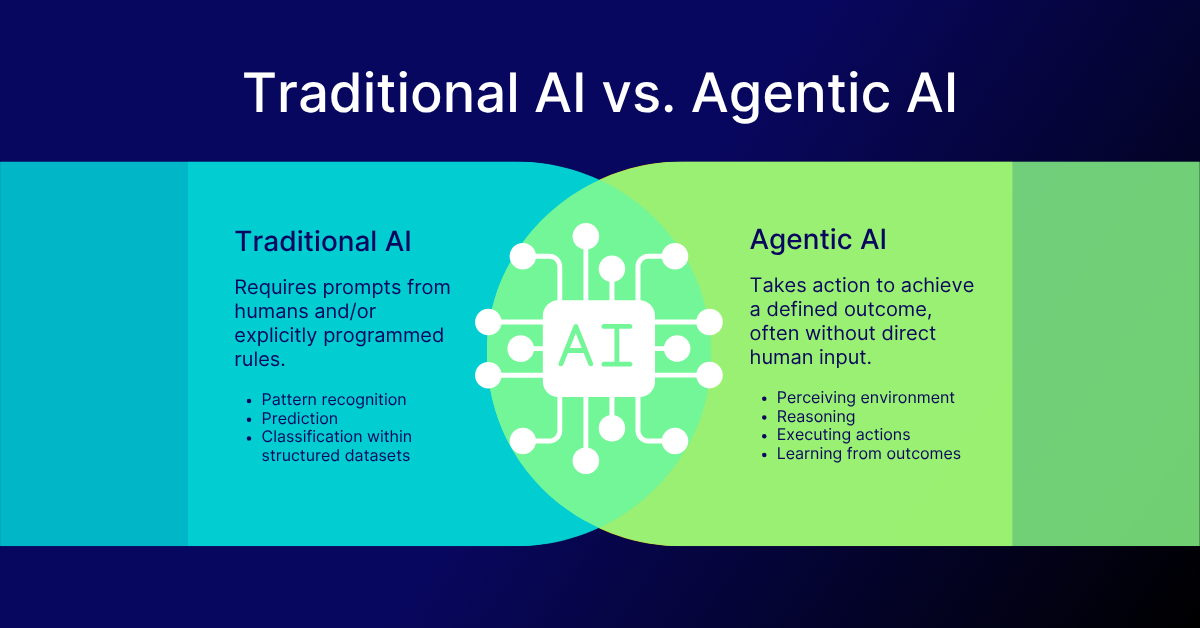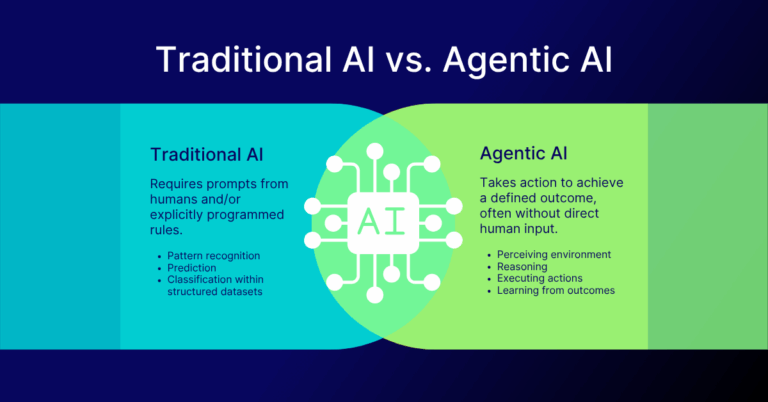In the rapidly evolving landscape of artificial intelligence, a new paradigm is emerging that promises to redefine how we interact with and leverage intelligent systems: Agentic AI. These systems are more than sophisticated tools; they are proactive entities designed to tackle specific tasks with a remarkable degree of independence.
“We know that governance, risk, and compliance teams see how AI can boost their process efficiency, and Agentic AI has the potential to completely redefine risk and compliance management. But, many organizations are still working to formalize their AI governance. Lengthy approval processes and unclear best practices are hindering AI adoption. It’s possible that even with the future emergence of Agentic AI capabilities within GRC tools like Risk Cloud, the true benefit may not be accessible to teams for quite some time due to organizational readiness.” – Amrutha Sivakumar, Senior Director, of Product Management at LogicGate
As AI continues to evolve, the gap between early adopters, late adopters, and non-adopters will become more and more significant. From operational efficiencies to stronger organizational resilience and competitive differentiators across the marketplace, leaders who take the time to understand today’s AI capabilities and tomorrow’s possibilities will better understand the potential impact and plan accordingly.
What’s The Difference Between Agentic AI and Traditional AI?
Unlike traditional AI, which typically operates within predefined parameters and requires constant human intervention, agentic AI is characterized by its ability to pursue goals autonomously, make independent decisions, and adapt to dynamic environments. This distinction is crucial, as it shifts the focus from merely processing information to actively solving problems and achieving objectives in the real world.
Traditional AI
- Definition: AI systems that require prompts from humans and/or explicitly programmed rules to generate a specific type of result(s).
- Excels At: Pattern recognition, prediction, and classification within structured datasets.
- Example 1: Manufacturing systems detecting defects on an assembly line.
- Example 2: Risk Cloud’s Spark AI providing data linking recommendations across teams and workflows.
Agentic AI
- Definition: AI systems designed with a clear objective and empowered to determine the best course of action to achieve that objective, even when faced with novel situations.
- Excels At: Perceiving its environment, reasoning about potential actions, executing those actions, and then learning from the outcomes. This dynamic and iterative process allows agentic AI to operate effectively in complex, unpredictable environments where traditional AI might falter.
- Example 1: Monitor global supply chain conditions, then re-plan logistics routes, re-allocate inventory, negotiate with alternative suppliers, and even initiate emergency orders to mitigate impact and ensure continuous operations.
- Example 2: Monitor transactions and financial data for anomalies indicative of fraud. Beyond simply flagging suspicious activity, an agentic system can autonomously investigate patterns, cross-reference with other data sources, and, if confirmed, take immediate action such as freezing accounts, blocking transactions, or generating a fraud report for human review.

Where Does Conversational AI Fit In?
Many of us encounter chatbots and virtual assistants on a regular basis. That’s conversational AI. These systems leverage natural language processing (NLP) to understand and generate human-like text or speech, facilitating communication and information retrieval. Its main goal is to engage in human-like dialogue, answer questions, and perform tasks based on explicit commands.
Conversational AI systems have started to blur the line between traditional and agentic AI, but generally are still considered traditional. Why? This mainly comes down to their primary purpose and level of autonomy. Its purpose is to engage in dialogue, answer questions, provide information, or complete tasks as instructed by the user. However, these tools act in response to user queries, not as independent, proactive entities with their own overarching objectives.
While an agentic AI might utilize conversational interfaces as a means to gather information or report progress, its fundamental purpose is to take action and achieve a defined outcome, often without direct human input during the execution phase. Think of it as the difference between a highly knowledgeable librarian (conversational AI) and a proactive project manager who executes plans and delegates tasks (agentic AI).
Applications of Agentic AI in Real-World Scenarios
The autonomous and goal-oriented nature of agentic AI makes it incredibly well-suited for optimizing complex workflows and problem-solving across a multitude of industries.
Benefits and Risks of Agentic AI in Healthcare
Agentic AI could manage intricate patient care pathways, autonomously adjusting treatment plans based on real-time patient data, scheduling follow-up appointments, and even coordinating with different specialists to ensure seamless care delivery. While stringent testing of this technology and ongoing risk mitigation would be required, the benefits of agentic AI in healthcare could be significant, even life-saving.
- Early Intervention: Agentic AI could introduce truly personalized and dynamic care, allowing for early detection of issues and timely interventions, which can significantly improve patient outcomes and potentially prevent costly complications or hospital readmissions.
- Holistic Patient Care: Agentic AI has the potential to coordinate communication among multiple specialists (e.g., primary care, cardiologist, physical therapist, nutritionist). This would ensure all parties are working with the most up-to-date information and adhering to the integrated care pathway.
- Healthcare Accessibility: The administrative and medical efficiencies introduced through the support of Agentic AI could increase the capacity of healthcare systems to manage more patients effectively, potentially expanding access to high-quality care.
These benefits are not achievable at scale with traditional AI. For example, traditional AI tools might predict patient readmission risk, but they wouldn’t then autonomously schedule interventions to prevent it. Agentic AI goes multiple steps further to intelligently automate complex workflows, enabling proactive problem-solving rather than just reactive analysis.
There are major risks associated with the use of Agentic AI in healthcare, many of which exist today within manual processes and widely-adopted systems. Examples include:
- AI hallucinations result in incorrect treatment plans, medication dosage, or diagnostic interpretations.
- Improper training of AI could lead to algorithmic bias and health inequities.
- Sensitive patient data (Protected Health Information – PHI) must be leveraged by Agentic AI systems, making them prime targets for cyberattacks, data leakage, and misuse.
Benefits and Risks of Agentic AI in Retail
Retailers stand to benefit significantly from Agentic AI over traditional AI and manual human-driven workflows, with benefits impacting both day-to-day operations, customer satisfaction, and market differentiators. Examples include:
- Real-Time Supply Chain Management: Agentic AI could anticipate potential issues within the supply chain (e.g., a supplier delay, a sudden spike in demand, a system malfunction) and autonomously initiate corrective measures to mitigate negative impacts before they fully materialize.
- Go-To-Market Optimization: Agentic AI could take a high-level goal (e.g., “maximize profit for Product X,” “ensure optimal customer satisfaction for online orders”) and autonomously create, then execute, the strategy.
- Increased Sales: Agentic AI could combine customer info with inventory, pricing, and promotional data to create truly dynamic and hyper-personalized shopping experiences, product recommendations, and targeted promotions in real-time.
Traditional AI struggles with the adaptation and ongoing orchestration needed to keep pace with dynamic supply chains and deeply personalized, multi-channel customer journeys. A traditional AI might predict a stockout, but agentic AI would autonomously initiate a new order with the best supplier, track its shipment, adjust store-level inventory transfers, and update pricing, all while keeping key stakeholders informed.
But with great benefits comes greater risk. As the use of agentic AI within retail becomes more and more feasible, new risks are appearing.
- An agent misconfigured or compromised could, for example, autonomously export customer lists, leak sales strategies, or make unauthorized transactions.
- Dynamic pricing or inventory allocation could inadvertently lead to price wars, market distortions, or unfair competition.
- Human staff might lose the nuanced understanding of common customer pain points, making them less effective when human intervention is needed.
Benefits and Risks of Agentic AI in Cybersecurity
The dynamic nature of agentic AI has the potential to serve and complicate the world of cybersecurity. Agentic AI’s ability to make immediate, informed decisions without human latency is paramount in the face of rapidly evolving cyber threats. Yet, these powerful systems and their interconnected nature also exaggerate the cyber risk landscape that we know today.
- Continuous Detection and Response: The ability to work 24/7/365 and autonomously analyze massive volumes of security data (logs, network traffic, endpoint data) in real-time, identify anomalies, then initiate containment actions (e.g., isolating a compromised system, blocking an IP address, deploying a patch) will significantly decrease the impact and scope of breaches.
- Adaptive Threat Hunting: Agentic AI learns from past incidents, observed attacker TTPs (Tactics, Techniques, and Procedures), and new threat intelligence to continuously refine its hunting queries and detection models, identifying novel or evolving threats that traditional signature-based systems would miss.
- Strategic Prioritization: Agentic AI could incorporate context like asset criticality and regulatory requirements into its decision-making, leading to intelligent prioritization.
- Automated Compliance: Agentic AI could monitor systems for compliance with various regulatory standards (e.g., GDPR, HIPAA, SOC 2), then automatically apply remediation steps to maintain continuous compliance.
Agentic AI has the potential to empower cybersecurity teams to transcend the limitations of current defense mechanisms, acting as an autonomous, always-on “super-analyst” that can proactively defend, detect, investigate, and respond to threats. This speed and scale is unachievable by human or traditional AI efforts alone, offering a pathway to a more resilient and efficient cybersecurity posture.
Cybersecurity teams are already grappling with the wave of new risks that agentic AI poses, both internal and external to their organizations. The most significant threat is the weaponization of agentic AI by cybercriminals and nation-state actors to:
- Develop malware and attack tools that dynamically adapt their tactics, techniques, and procedures (TTPs) in real-time to bypass security controls, making them much harder to detect and contain.
- Conduct highly sophisticated phishing campaigns (spear-phishing) at an unprecedented scale, generate diverse malware variants that evade traditional defenses, and automate vulnerability scanning and exploitation.
- Orchestrate massive, highly distributed DDoS attacks where requests appear legitimate, making them difficult to block.
- Compromise AI agents with excessive permissions to gain highly privileged access across the network.
There are also many non-malicious ways in which Agentic AI could threaten the cybersecurity posture of an organization, like:
- A narrowly defined goal (e.g., “maximize system uptime”) leading to actions that unintentionally compromise security (e.g., disabling security updates to prevent downtime).
- Autonomous interactions between multiple AI agents could lead to unpredictable emergent behaviors, resulting in new vulnerabilities.
- The inability to effectively investigate security incidents, attribute actions, or comply with regulatory requirements when AI’s decision-making process and actions aren’t thoroughly logged.
The Future of Agentic AI
The potential of agentic AI to transform AI-powered ecosystems is immense. We can envision a future where intelligent agents seamlessly collaborate to manage smart cities, optimize global energy grids, or even conduct scientific research with unprecedented speed and efficiency.
However, this transformative potential also comes with significant challenges that must be addressed. Scalability will be a key hurdle, as designing and deploying agentic systems that can operate safely and effectively across vast and complex domains will require robust architectures and sophisticated learning mechanisms. Human oversight remains a critical consideration; while agentic AI offers autonomy, the need for human monitoring and intervention, particularly in high-stakes environments, will persist to ensure safety, ethical compliance, and accountability.
Finally, ethical considerations are paramount. As agentic AI systems become more autonomous and influential, questions surrounding bias, transparency, responsibility for errors, and the potential for unintended consequences will need to be meticulously addressed through careful design, rigorous testing, and comprehensive regulatory frameworks. The future of agentic AI is not just about building smarter machines, but about building them responsibly, ensuring they serve humanity’s best interests while navigating the complexities of an increasingly autonomous world.
